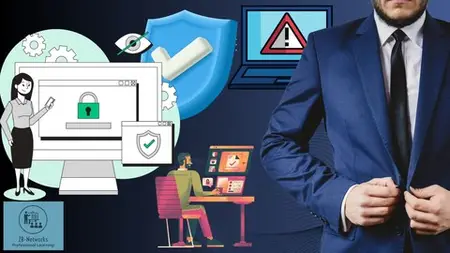Bgp Fundamentals And Advanced Topics: All-In-One Course
Published 8/2024
MP4 | Video: h264, 1920x1080 | Audio: AAC, 44.1 KHz
Language: English | Size: 6.01 GB | Duration: 8h 5m
Published 8/2024
MP4 | Video: h264, 1920x1080 | Audio: AAC, 44.1 KHz
Language: English | Size: 6.01 GB | Duration: 8h 5m
Master the Essentials and Advanced Techniques of Border Gateway Protocol (BGP) for Network Stability and Performance
What you'll learn
Understanding the role and importance of BGP in networking
Differences between Interior Gateway Protocols (IGPs) and Exterior Gateway Protocols (EGPs)
BGP attributes and how they influence routing decisions
Path selection process
BGP message types (OPEN, UPDATE, NOTIFICATION, KEEPALIVE)
Configuring basic BGP settings
Establishing BGP sessions (iBGP and eBGP)
BGP route aggregation and summarization
Route reflectors and confederations
BGP multi-homing
BGP Policy and Filtering
BGP Scalability and Performance
Implementing BGP security features (e.g., TTL Security Check, MD5 authentication)
Tools and techniques for BGP troubleshooting
Use cases for BGP in large-scale networks
Real-world lab exercises to reinforce theoretical knowledge
Requirements
Basic Networking Knowledge
Understanding of Routing Protocols
Access to Networking Lab Environment
Basic Command-Line Skills
Description
Welcome to "BGP Fundamentals and Advanced Topics: All-in-One Course," the ultimate guide to mastering Border Gateway Protocol (BGP) from the ground up. Whether you're a network engineer, IT professional, or a student eager to expand your networking knowledge, this comprehensive course will equip you with the skills and understanding necessary to implement, manage, and troubleshoot BGP in any networking environment.What You’ll LearnIntroduction to BGPThe role and importance of BGP in modern networkingKey differences between IGPs and EGPsBGP BasicsBGP attributes and their impact on routing decisionsUnderstanding BGP message types (OPEN, UPDATE, NOTIFICATION, KEEPALIVE)BGP path selection processBGP Configuration and ImplementationSetting up BGP on routersConfiguring basic BGP settings and establishing BGP sessions (iBGP and eBGP)Managing BGP neighbor relationshipsAdvanced BGP ConceptsBGP route aggregation and summarizationImplementing route reflectors and confederationsUsing BGP communities for routing policiesMulti-homing and redundancy in BGPBGP Policy and FilteringApplying route maps, prefix lists, and access lists with BGPImplementing BGP policies to control routing behaviorFiltering BGP routes to ensure network stability and securityBGP Scalability and PerformanceEnhancing BGP scalability techniquesReducing BGP convergence timeBest practices for optimizing BGP performanceBGP SecurityIdentifying and mitigating common BGP security threatsImplementing BGP security features like TTL Security Check and MD5 authenticationBest practices for securing BGP implementationsBGP Troubleshooting and MonitoringCommon BGP issues and troubleshooting techniquesTools and methods for BGP monitoring and diagnosticsEnsuring BGP performance and stability in your networkBGP in Data Centers and Service Provider NetworksThe role of BGP in modern data centersBGP applications in service provider environmentsReal-world use cases for BGP in large-scale networksReal-World BGP Scenarios and Case StudiesAnalyzing and solving real-world BGP implementation scenariosCase studies demonstrating effective BGP solutions for network challengesBGP and SDN (Software-Defined Networking)Integrating BGP with SDN architecturesExploring future trends and developments in BGP and networkingHands-On Labs and Practical ExercisesConfiguring BGP in simulated environmentsReal-world lab exercises to reinforce theoretical knowledgeStep-by-step guides for implementing BGP solutionsRequirementsBasic networking knowledge (IP addressing, subnetting)Familiarity with common networking devices (routers, switches)Basic experience with network configuration using CLIUnderstanding of basic routing protocols (OSPF, EIGRP)Access to a networking lab environment (physical or virtual) for practiceWho This Course is ForNetwork engineers and administratorsNetwork architectsIT professionals and support teamsStudents and learners in networking fieldsSystem administratorsTelecommunications professionalsCybersecurity professionalsNetworking enthusiastsWhy Enroll?By the end of this course, you will have a thorough understanding of BGP, from fundamental concepts to advanced techniques. You will be equipped with practical skills to implement, configure, and troubleshoot BGP in various networking environments, making you a valuable asset in any network operations or engineering team. Enroll today and take the next step in your networking career!
Overview
Section 1: Introduction
Lecture 1 Introduction
Section 2: BGP Introduction
Lecture 2 Basics of BGP
Lecture 3 Understanding eBGP & iBGP
Lecture 4 Setting up the topology
Lecture 5 Lab: Basic BGP Configuration
Lecture 6 BGP Route Advertisement
Lecture 7 BGP Route Advertisement Continued
Section 3: BGP Features Explained
Lecture 8 BGP Redistribute Connected Feature
Lecture 9 Redistributing IGP into BGP Methods
Lecture 10 eBGP Multihop Theory & Lab
Lecture 11 eBGP MD5 Authentication Theory and Lab
Lecture 12 iBGP Configuring Underlay Routing
Lecture 13 Configuring iBGP using loopbacks and route propagation
Lecture 14 Configuring Next Hop Self feature in iBGP and route propagation
Lecture 15 iBGP Full Mesh and Route Reflector Theory
Lecture 16 iBGP Full Mesh and Route Reflector Theory & Lab
Lecture 17 iBGP Peer-Group Theory
Lecture 18 iBGP Peer-Group Lab
Lecture 19 Demistifying Access-list and Prefix-List for Route-Filtering - Part-1
Lecture 20 Demistifying Access-list and Prefix-List for Route-Filtering - Part-2
Lecture 21 Configuring Route-Filtering in BGP - ACL Method
Lecture 22 Configuring Route-Filtering in BGP - Prefix-List
Professionals responsible for configuring, managing, and maintaining network infrastructures.,Those looking to deepen their knowledge of routing protocols and enhance their network engineering skills.,IT staff seeking to expand their expertise in network protocols and routing technologies.,Support engineers responsible for diagnosing and resolving network issues.,Individuals preparing for networking certifications (e.g., Cisco CCNP, Juniper JNCIS, or equivalent),Self-learners seeking to acquire new skills in network routing and protocols.



